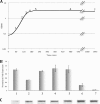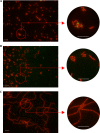Characterization of Acp, a peptidoglycan hydrolase of Clostridium perfringens with N-acetylglucosaminidase activity that is implicated in cell separation and stress-induced autolysis
- PMID: 20190047
- PMCID: PMC2863477
- DOI: 10.1128/JB.01546-09
Characterization of Acp, a peptidoglycan hydrolase of Clostridium perfringens with N-acetylglucosaminidase activity that is implicated in cell separation and stress-induced autolysis
Abstract
This work reports the characterization of the first known peptidoglycan hydrolase (Acp) produced mainly during vegetative growth of Clostridium perfringens. Acp has a modular structure with three domains: a signal peptide domain, an N-terminal domain with repeated sequences, and a C-terminal catalytic domain. The purified recombinant catalytic domain of Acp displayed lytic activity on the cell walls of several Gram-positive bacterial species. Its hydrolytic specificity was established by analyzing the Bacillus subtilis peptidoglycan digestion products by coupling reverse phase-high-pressure liquid chromatography (RP-HPLC) and matrix-assisted laser desorption ionization-time of flight mass spectrometry (MALDI-TOF MS) analysis, which displayed an N-acetylglucosaminidase activity. The study of acp expression showed a constant expression during growth, which suggested an important role of Acp in growth of C. perfringens. Furthermore, cell fractionation and indirect immunofluorescence staining using anti-Acp antibodies revealed that Acp is located at the septal peptidoglycan of vegetative cells during exponential growth phase, indicating a role in cell separation or division of C. perfringens. A knockout acp mutant strain was obtained by using the insertion of mobile group II intron strategy (ClosTron). The microscopic examination indicated a lack of vegetative cell separation in the acp mutant strain, as well as the wild-type strain incubated with anti-Acp antibodies, demonstrating the critical role of Acp in cell separation. The comparative responses of wild-type and acp mutant strains to stresses induced by Triton X-100, bile salts, and vancomycin revealed an implication of Acp in autolysis induced by these stresses. Overall, Acp appears as a major cell wall N-acetylglucosaminidase implicated in both vegetative growth and stress-induced autolysis.
Figures












Similar articles
-
Acd, a peptidoglycan hydrolase of Clostridium difficile with N-acetylglucosaminidase activity.Microbiology (Reading). 2005 Jul;151(Pt 7):2343-2351. doi: 10.1099/mic.0.27878-0. Microbiology (Reading). 2005. PMID: 16000724
-
Characterization of AtlL, a bifunctional autolysin of Staphylococcus lugdunensis with N-acetylglucosaminidase and N-acetylmuramoyl-l-alanine amidase activities.FEMS Microbiol Lett. 2009 Jan;290(1):105-13. doi: 10.1111/j.1574-6968.2008.01414.x. Epub 2008 Nov 13. FEMS Microbiol Lett. 2009. PMID: 19025571
-
Structural and biochemical characterization of the Clostridium perfringens autolysin catalytic domain.FEBS Lett. 2017 Jan;591(1):231-239. doi: 10.1002/1873-3468.12515. Epub 2016 Dec 19. FEBS Lett. 2017. PMID: 27926788
-
Bacterial peptidoglycan (murein) hydrolases.FEMS Microbiol Rev. 2008 Mar;32(2):259-86. doi: 10.1111/j.1574-6976.2007.00099.x. Epub 2008 Feb 11. FEMS Microbiol Rev. 2008. PMID: 18266855 Review.
-
Controlling Autolysis During Flagella Insertion in Gram-Negative Bacteria.Adv Exp Med Biol. 2017;925:41-56. doi: 10.1007/5584_2016_52. Adv Exp Med Biol. 2017. PMID: 27722959 Review.
Cited by
-
The WalRK Two-Component System Is Essential for Proper Cell Envelope Biogenesis in Clostridioides difficile.J Bacteriol. 2022 Jun 21;204(6):e0012122. doi: 10.1128/jb.00121-22. Epub 2022 May 16. J Bacteriol. 2022. PMID: 35575581 Free PMC article.
-
Global transcriptional control by glucose and carbon regulator CcpA in Clostridium difficile.Nucleic Acids Res. 2012 Nov;40(21):10701-18. doi: 10.1093/nar/gks864. Epub 2012 Sep 18. Nucleic Acids Res. 2012. PMID: 22989714 Free PMC article.
-
Neisseria gonorrhoeae virulence factor NG1686 is a bifunctional M23B family metallopeptidase that influences resistance to hydrogen peroxide and colony morphology.J Biol Chem. 2012 Mar 30;287(14):11222-33. doi: 10.1074/jbc.M111.338830. Epub 2012 Feb 13. J Biol Chem. 2012. PMID: 22334697 Free PMC article.
-
Biochemical Characterizations of the Putative Endolysin Ecd09610 Catalytic Domain from Clostridioides difficile.Antibiotics (Basel). 2022 Aug 20;11(8):1131. doi: 10.3390/antibiotics11081131. Antibiotics (Basel). 2022. PMID: 36010000 Free PMC article.
-
Structural and Biochemical Insights into the Peptidoglycan Hydrolase Domain of FlgJ from Salmonella typhimurium.PLoS One. 2016 Feb 12;11(2):e0149204. doi: 10.1371/journal.pone.0149204. eCollection 2016. PLoS One. 2016. PMID: 26871950 Free PMC article.
References
-
- Allignet, J., P. England, I. Old, and N. El Solh. 2002. Several regions of the repeat domain of the Staphylococcus caprae autolysin, AtlC, are involved in fibronectin binding. FEMS Microbiol. Lett. 213:193-197. - PubMed
-
- Bateman, A., and M. Bycroft. 2000. The structure of a LysM domain from E. coli membrane-bound lytic murein transglycosylase D (MltD). J. Mol. Biol. 299:1113-1119. - PubMed
-
- Bourgeois, I., E. Camiade, R. Biswas, P. Courtin, L. Gibert, F. Gotz, M. P. Chapot-Chartier, J. L. Pons, and M. Pestel-Caron. 2009. Characterization of AtlL, a bifunctional autolysin of Staphylococcus lugdunensis with N-acetylglucosaminidase and N-acetylmuramoyl-l-alanine amidase activities. FEMS Microbiol. Lett. 290:105-113. - PubMed
Publication types
MeSH terms
Substances
Associated data
- Actions
Grants and funding
LinkOut - more resources
Full Text Sources
Other Literature Sources
Molecular Biology Databases

